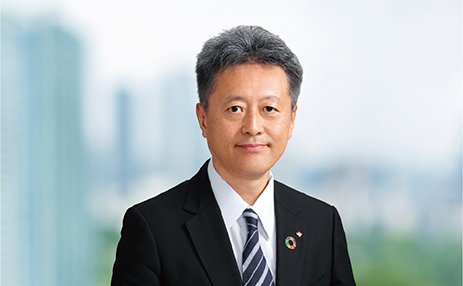Message from the Senior General Manager
In collaboration with a well-balanced and robust derivative chain, we aim to expand our value-added product line by selling each fraction produced by our naphtha cracker and using them more effectively. In order to secure stable profits in a changing business environment, we will strengthen our competitiveness by pursuing the diversification of raw materials and the improvement of naphtha cracker efficiency. In addition, we aim to explore and deepen our business by setting targets for each product line, with sales, R&D, and manufacturing working together with a focus on information sharing.

Hidetoshi Horiuchi
Vice President
Senior General Manager, Olefins Division
SWOT Analysis
Strengths
- Sole owner of a naphtha cracker in the Chukyo region
- Stable demand for derivatives
- Agility through ownership of ethylene carrier
Weaknesses
- Easily impacted by changes in demand for derivatives
- Easily impacted by price fluctuations of raw materials and fuels
- Increase in maintenance costs due to aging of facilities
Opportunities
- Strong demand growth in Asia
- Further downstream development (M&A related to derivatives)
- Response to carbon neutrality
Threats
- Economic slowdown, declining demand and supply chain disruptions due to COVID-19 pandemic
- Unexpected influx of petrochemical products from China
- Demand and price fluctuations due to geopolitical risk
Review of Previous Medium-term Business Plan
We worked to strengthen the competitiveness of our naphtha cracker from 2018 to 2020 by streamlining facilities through the installation of new gas turbines and a new cracking furnace as well as by upgrading the existing cracking furnace. Although the first half of fiscal 2020 was impacted by a sharp drop in raw material prices and a decline in demand, mainly in the automobile sector, owing to the COVID-19 pandemic, the naphtha cracker was in high operation the rest of the time as we worked to supply raw materials to meet demand for derivatives.
Strategy Under New Medium-term Business Plan
To further strengthen the foundation of our Commodity business, we will work to improve cost competitiveness and stabilize operations of our naphtha cracker, while deepening our Petrochemical business by integrating production, research, and sales linked with demand for derivatives. We intend to augment our lines of value-added products through the sale and effective use of each fraction produced by our naphtha cracker in collaboration with a robust derivative chain. We will also create a system enabling us to secure profits even in a changing environment.